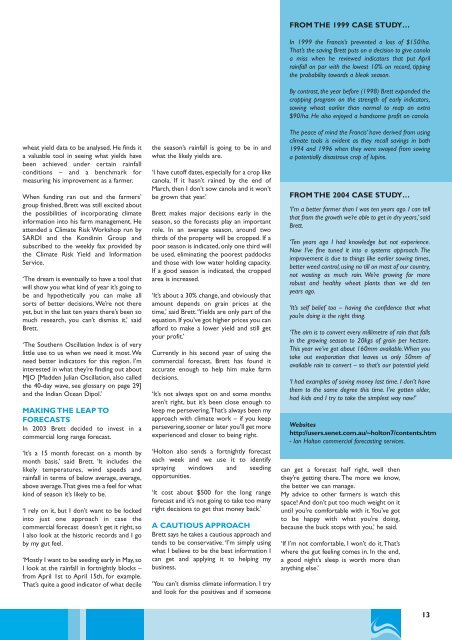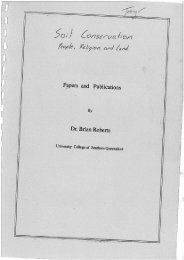Masters of the Climate: Innovative farmers ... - South West NRM
Masters of the Climate: Innovative farmers ... - South West NRM
Masters of the Climate: Innovative farmers ... - South West NRM
You also want an ePaper? Increase the reach of your titles
YUMPU automatically turns print PDFs into web optimized ePapers that Google loves.
wheat yield data to be analysed. He finds it<br />
a valuable tool in seeing what yields have<br />
been achieved under certain rainfall<br />
conditions – and a benchmark for<br />
measuring his improvement as a farmer.<br />
When funding ran out and <strong>the</strong> <strong>farmers</strong>’<br />
group finished, Brett was still excited about<br />
<strong>the</strong> possibilities <strong>of</strong> incorporating climate<br />
information into his farm management. He<br />
attended a <strong>Climate</strong> Risk Workshop run by<br />
SARDI and <strong>the</strong> Kondinin Group and<br />
subscribed to <strong>the</strong> weekly fax provided by<br />
<strong>the</strong> <strong>Climate</strong> Risk Yield and Information<br />
Service.<br />
‘The dream is eventually to have a tool that<br />
will show you what kind <strong>of</strong> year it’s going to<br />
be and hypo<strong>the</strong>tically you can make all<br />
sorts <strong>of</strong> better decisions. We’re not <strong>the</strong>re<br />
yet, but in <strong>the</strong> last ten years <strong>the</strong>re’s been so<br />
much research, you can’t dismiss it,’ said<br />
Brett.<br />
‘The Sou<strong>the</strong>rn Oscillation Index is <strong>of</strong> very<br />
little use to us when we need it most.We<br />
need better indicators for this region. I’m<br />
interested in what <strong>the</strong>y’re finding out about<br />
MJO [Madden Julian Oscillation, also called<br />
<strong>the</strong> 40-day wave, see glossary on page 29]<br />
and <strong>the</strong> Indian Ocean Dipol.’<br />
MAKING THE LEAP TO<br />
FORECASTS<br />
In 2003 Brett decided to invest in a<br />
commercial long range forecast.<br />
‘It’s a 15 month forecast on a month by<br />
month basis,’ said Brett. ‘It includes <strong>the</strong><br />
likely temperatures, wind speeds and<br />
rainfall in terms <strong>of</strong> below average, average,<br />
above average.That gives me a feel for what<br />
kind <strong>of</strong> season it’s likely to be.<br />
‘I rely on it, but I don’t want to be locked<br />
into just one approach in case <strong>the</strong><br />
commercial forecast doesn’t get it right, so<br />
I also look at <strong>the</strong> historic records and I go<br />
by my gut feel.<br />
‘Mostly I want to be seeding early in May, so<br />
I look at <strong>the</strong> rainfall in fortnightly blocks –<br />
from April 1st to April 15th, for example.<br />
That’s quite a good indicator <strong>of</strong> what decile<br />
<strong>the</strong> season’s rainfall is going to be in and<br />
what <strong>the</strong> likely yields are.<br />
‘I have cut<strong>of</strong>f dates, especially for a crop like<br />
canola. If it hasn’t rained by <strong>the</strong> end <strong>of</strong><br />
March, <strong>the</strong>n I don’t sow canola and it won’t<br />
be grown that year.’<br />
Brett makes major decisions early in <strong>the</strong><br />
season, so <strong>the</strong> forecasts play an important<br />
role. In an average season, around two<br />
thirds <strong>of</strong> <strong>the</strong> property will be cropped. If a<br />
poor season is indicated, only one third will<br />
be used, eliminating <strong>the</strong> poorest paddocks<br />
and those with low water holding capacity.<br />
If a good season is indicated, <strong>the</strong> cropped<br />
area is increased.<br />
‘It’s about a 30% change, and obviously that<br />
amount depends on grain prices at <strong>the</strong><br />
time,’ said Brett.‘Yields are only part <strong>of</strong> <strong>the</strong><br />
equation. If you’ve got higher prices you can<br />
afford to make a lower yield and still get<br />
your pr<strong>of</strong>it.’<br />
Currently in his second year <strong>of</strong> using <strong>the</strong><br />
commercial forecast, Brett has found it<br />
accurate enough to help him make farm<br />
decisions.<br />
‘It’s not always spot on and some months<br />
aren’t right, but it’s been close enough to<br />
keep me persevering.That’s always been my<br />
approach with climate work – if you keep<br />
persevering, sooner or later you’ll get more<br />
experienced and closer to being right.<br />
‘Holton also sends a fortnightly forecast<br />
each week and we use it to identify<br />
spraying windows and seeding<br />
opportunities.<br />
‘It cost about $500 for <strong>the</strong> long range<br />
forecast and it’s not going to take too many<br />
right decisions to get that money back.’<br />
A CAUTIOUS APPROACH<br />
Brett says he takes a cautious approach and<br />
tends to be conservative. ‘I’m simply using<br />
what I believe to be <strong>the</strong> best information I<br />
can get and applying it to helping my<br />
business.<br />
‘You can’t dismiss climate information. I try<br />
and look for <strong>the</strong> positives and if someone<br />
FROM THE 1999 CASE STUDY…<br />
In 1999 <strong>the</strong> Francis’s prevented a loss <strong>of</strong> $150/ha.<br />
That’s <strong>the</strong> saving Brett puts on a decision to give canola<br />
a miss when he reviewed indicators that put April<br />
rainfall on par with <strong>the</strong> lowest 10% on record, tipping<br />
<strong>the</strong> probability towards a bleak season.<br />
By contrast, <strong>the</strong> year before (1998) Brett expanded <strong>the</strong><br />
cropping program on <strong>the</strong> strength <strong>of</strong> early indicators,<br />
sowing wheat earlier than normal to reap an extra<br />
$90/ha. He also enjoyed a handsome pr<strong>of</strong>it on canola.<br />
The peace <strong>of</strong> mind <strong>the</strong> Francis’ have derived from using<br />
climate tools is evident as <strong>the</strong>y recall savings in both<br />
1994 and 1996 when <strong>the</strong>y were swayed from sowing<br />
a potentially disastrous crop <strong>of</strong> lupins.<br />
FROM THE 2004 CASE STUDY…<br />
‘I’m a better farmer than I was ten years ago. I can tell<br />
that from <strong>the</strong> growth we’re able to get in dry years,’ said<br />
Brett.<br />
‘Ten years ago I had knowledge but not experience.<br />
Now I’ve fine tuned it into a systems approach. The<br />
improvement is due to things like earlier sowing times,<br />
better weed control, using no till on most <strong>of</strong> our country,<br />
not wasting as much rain. We’re growing far more<br />
robust and healthy wheat plants than we did ten<br />
years ago.<br />
‘It’s self belief too – having <strong>the</strong> confidence that what<br />
you’re doing is <strong>the</strong> right thing.<br />
‘The aim is to convert every millimetre <strong>of</strong> rain that falls<br />
in <strong>the</strong> growing season to 20kgs <strong>of</strong> grain per hectare.<br />
This year we’ve got about 160mm available.When you<br />
take out evaporation that leaves us only 50mm <strong>of</strong><br />
available rain to convert – so that’s our potential yield.<br />
‘I had examples <strong>of</strong> saving money last time. I don’t have<br />
<strong>the</strong>m to <strong>the</strong> same degree this time. I’ve gotten older,<br />
had kids and I try to take <strong>the</strong> simplest way now!’<br />
Websites<br />
http://users.senet.com.au/~holton7/contents.htm<br />
- Ian Holton commercial forecasting services.<br />
can get a forecast half right, well <strong>the</strong>n<br />
<strong>the</strong>y’re getting <strong>the</strong>re. The more we know,<br />
<strong>the</strong> better we can manage.<br />
My advice to o<strong>the</strong>r <strong>farmers</strong> is watch this<br />
space! And don’t put too much weight on it<br />
until you’re comfortable with it.You’ve got<br />
to be happy with what you’re doing,<br />
because <strong>the</strong> buck stops with you,’ he said.<br />
‘If I’m not comfortable, I won’t do it.That’s<br />
where <strong>the</strong> gut feeling comes in. In <strong>the</strong> end,<br />
a good night’s sleep is worth more than<br />
anything else.’<br />
13
















